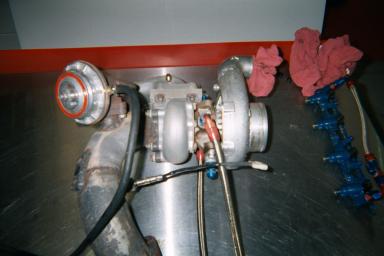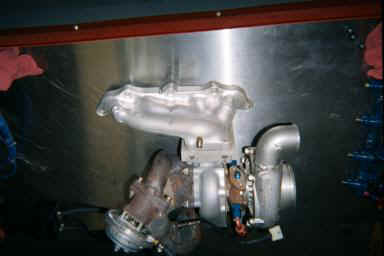Home of The Shuttle...
Home The Cars The Humor Contact Me
Visitor Number
|
Welcome
to
TurboCelica.com.. Home of The Shuttle... |
Navigation
Menu Home The Cars The Humor Contact Me |
Visitor Number |
My Automotive FAQ - Installation of oil and water lines for a bybrid T04/T3 turbo
The oil lines
Inlet line: The stock oil feed line connects to the block with a banjo fitting and a long and hollow, 18 mm bolt. (I forget the thread pitch, but it's likely "1.25".) It just so happens that you can get an 18mm oil drain plug from an auto parts store, and have it drilled and tapped to 1/8" FNPT. (I didn't learn of 18mm oil drain plugs till after I had this 18mm x 1/8" FNPT fitting custom-made for me, so benefit from my experience.) Next get an 1/8" MNPT to AN-6 flare fitting to affix into the drain plug. At this point, you have what you need to affix a Stainless Steel (SS) line to the block using the same oil feed hole. On the turbo, I believe it also has 1/8" F NPT so you'll need another 1/8" male NPT to AN6 flare fitting. At this point, you merely need to fabricate a SS hose to connect the turbo to the fitting in the block, or, be lucky enough to find a pre-made SS line about 18" in length with the female AN6 fittings. The hose I use has a 45 deg bend at the block and a 90 deg at the turbo. For what it's worth, photo #1 below (upside down) that shows the turbo assembly from which you can barely make out the blue Earl fitting. Ignore the SS lines you see in this photo; these are the water cooling lines, which you WILL want to fabricate. I'll discuss them later.
Drain line: There is a small aluminum plate which bolts to the turbo, sealed with a gasket, which provides a large 3/8" female NPT. So get a 3/8" to AN12 flare fitting. Yes, big, big, big line. Oil becomes frothy after passing through the turbo (or so I'm told - I've never "seen" this) and it's not under pressure, so you want a large, free-flowing line that does not hamper the return of oil to the oil pan. On the pan, remove the factory drain hose to uncover a large 1-1/8" nipple. At this point, you have a choice. You can try finding a hose that fits over the AN12 SS line and this large nipple and use some very robust hose clamps.... Or, you need to unscrew the large nipple from the oil pan, and have a special item manufactured to screw into the oil pan and then provide either 3/8" or 1/2" female NPT in which you can affix another fitting which exposes an AN12 flare. You need to guess which route I took. The fitting cost me $80 for 1 or $90 for 2, so I got two so that I could give one to my friends at Alamo because if my turbo oil return line leaked, I presumed that nearly all other cars they had fitted with the first option probably also leaked, and they needed to know about this solution. But *that's* a different story. So, I unfortunately do not have another one of these fittings, but I could likely have another made for you, for $80. Do I hear a GP for all who aspire to eventually have a Turbonetics turbo? On the AN12 hose, I used a 45 deg fitting at the turbo, in order to angle the hose back and toward the oil pan fitting. I recall thinking to myself "Gee. I'm spending more that $100 for the oil drain line. What have I gotten myself into?" Sometime shortly thereafter, I stopped itemizing my expenses in an Excel spreadsheet because it was getting to be depressing. That, too, is another story in itself.
The water lines
You should be able to use some high-temp hose and some nipple fittings on the turbo to connect the turbo to the factory water system. To do this, you will need to cut the excess metal from two places. One is the metal tube which connects the two upper radiator hoses. This tube has a small pipe on it that leads to the factory turbo. Whack-off all but about 3/4" to use as a nipple for the high temp hose. The other fitting is on the water pipe which leads from the water pump, across the front of the engine, makes a hard left to go under the distributor and to the rear of the block and the heater core. There are actually two pipes in this assembly. find the pipe which has a smaller pipe coming off it at about the point where it turns hard left to head rearward and under the distributor. Like the radiator pipe, whack-off all but about 3/4" such that it can also serve as a nipple. At this point, you can hose clamp some high temp hose to these
nipples and the turbo. However, I have a warning for you. Please ensure that these water lines do not come close to the exhaust
down-pipe because, like the oil lines, you don't want any leaks. While you will likely catch a rising temp gauge before the engine gets too hot, a little extra though and care when implementing these lines will keep you out of trouble. As an
added benefit, you may want to insulate these hoses to protect from the ravages of the heat. With all that said, let me admit that this configuration offered me tireless fits of frustrations as I kept getting coolant leaks in the hose I was using, and it's all due to the incredibly tight and close proximity with in which to run all these lines. there just isn't much room for all this. So.... I took the road less
traveled and had both water lines fitted with 1/4" thick plates through which 1/4" NPT was tapped so that I could, you guessed it, utilize SS lines for the water lines. If you go this route, find someone very adept at either brazing or using silver solder because the tubes are too darn thin-walled for conventional welding. I think that with some planning and careful consideration, you should get by ok with the high temp hose route. however, if you're a glutton for punishment and want to go the extra mile, pull both tubes off the car and have them fitted with 1/4"
NPT. You won't be sorry. If you do this, go ahead and replace all the little rubber hoses that you touch. There are several that you should replace at that time rather than having to pull everything back down at a later date only to replace that small, yet very important, hose. There are hoses connecting the water pump pipe to the oil cooler, the rear of the block, the heater core, and the water neck just
affront the distributor. These hoses are a pain to replace individually.
Issues to remember
and consider...
1. SS lines will CUT through most materials if the SS lines are allowed to rub against other items. Route all SS lines such that they don't rub anything, or they are jacketed to prevent abrasion (either use tubing insulation, or slit a rubber hose with an ID identical to the OD of the SS hose; secure with tie-wraps), or you have everything tie-wrapped so tightly such that while the line touches something else, it does rub.
2. I needn't remind you (but I will) that the oiling system is hyper-critical to the health and life of your engine, so when you tinker with it, be very careful, and know what you're doing. I highly recommend you avoid the temptation to skimp and jury-rig something less costly. You don't want to spring an oil leak or cause some other unforeseen damage just because you were trying to save a few bucks. Expect to spend a decent wad on good quality Earl or Aeroquip parts. The AN12 fittings are incredibly expensive, like $20-25 each, and you'll use 4 of them - 2 on the hose, and one each on the turbo and oil pan.
3. You will hear some people claim that you needn't water cool the turbo. I say this is rubbish if you want the turbo to last. Yes, many turbos lack water cooling jackets in the center section. But my thoughts are this: if the turbo has cooling line connections, only a fool would not use them on a street car. On a race car, it's likely debatable whether they're worth the hassle. And on the GT4, they can be a pain in the ole posterior.
4. I use and recommend the use of Teflon tape on all NPT threads, and I also used sparse amounts around the 18mm fitting in the block. Don't allow an Teflon tape to get inside any of the fittings - keep it on the NPT threads - so bits of Teflon tape do not get circulated with the oil. Use the oil drain plug gasket in addition to Teflon tape on the 18mm fitting in the block.
The following photos are of my turbo assembly.


|
|
Return to My Automotive FAQ |